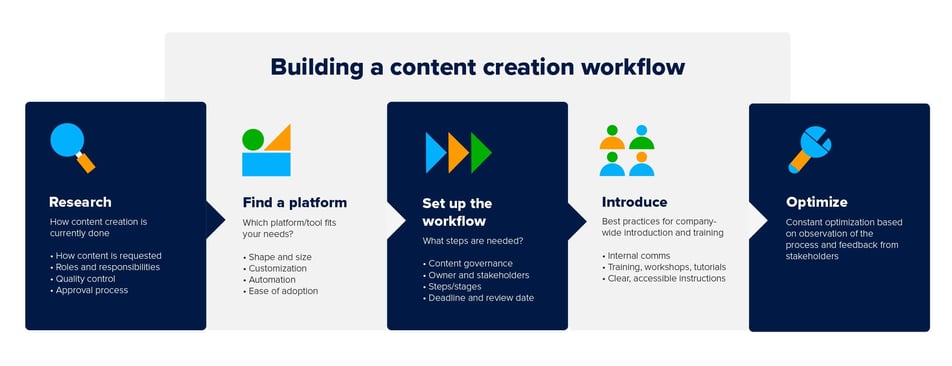Picture this: you receive content requests left and right, via email and direct messages. Someone might even tap you on the shoulder and deliver one in person. You navigate through five different communication channels, trying to remember who tagged you and where and what each requester wants and needs.
You juggle these requests, trying to assign them to the right people and define the priority level, hoping that the content creators deliver them on time, in high quality. Someone sends you a private message asking how the urgently needed white paper is coming along.
The chaos builds.
This approach might work for some. However, the absence of a structured content creation workflow is often the root of issues in content production. Lack of ownership, clear deadlines, and poor quality assurance quickly lead to content getting stuck or lost — and everyone’s nerves being tested.
When built well, a content creation workflow holds all the elements from clear task paths to coherent documentation and from quality control to stakeholder management. Its sole purpose is to provide an environment for an idea to become a top-notch piece of content. It’s essential that the workflow is well understood and adopted by everyone involved in the production process and that they all use it uniformly.
Where to start and what to consider
It may feel overwhelming to start building a content creation process. You can begin by gathering as much information as possible about how the creation is done currently: how content requests are submitted, what the roles and responsibilities are, and how each piece's quality control and approval are executed. Based on this information, you should be able to pick a platform or a tool that meets your company’s needs.
Here at Foleon, we create a ton of content, so we use a project management tool, Monday.com, for its customizability and a wide variety of possibilities. Besides customization, I value the ability to include automation in the process. Who doesn’t love automated workflows? A task is assigned to a creator; the system notifies them. A content piece is published; the system moves it to the published section. Reducing manual labor — yes, please!
Setting up the workflow can be time-consuming, but good planning and groundwork help a lot. The design depends heavily on your company structure and the type of content you create, but the main ingredients for this piece of the process are:
- Where is the content located?
For everyone involved to have easy access to the content, it’s important to add a direct link to it in the workflow.
Tip: Remember to add a live link once the piece is published for easy accessibility. - Who owns the content piece?
Who’s responsible for taking the task through the workflow and ensuring it becomes a full-grown content piece?
Tip: Create automation to notify the owner when a stage changes. - Who are the stakeholders involved?
Besides a content owner, there probably are other people involved in the creation process, e.g., copywriter, designer, content marketer, etc. Include all these stakeholders in the workflow for seamless collaboration. - What steps does the item need to take in the workflow?
It’s not called a workflow for nothing: for the process to work, the item should effortlessly move through the path built for it. Therefore, it’s crucial to have some sort of stages or steps in place to take along the way.
A task is assigned — a content creator picks it up and works on it — the text is ready for a review and quality assurance — the piece is published. These are the very basics — there can be multiple additional steps such as iterations and approvals from stakeholders. - What’s the deadline (and review date)?
Well-defined (and realistic) deadlines help with prioritizing and structuring the work.
Tip: Make sure to include a review date in the workflow to remind the content owners to look after published content. It’s important to revisit it regularly to see if it’s still relevant, up-to-date, and on-brand.
Guide the user through the flow
Ideally, a content creation workflow should be built in a logical way for any user. However, it’s always a good idea to create a set of instructions for use and attach them to the workflow. You can do this by adding them as a link to the workflow description or creating step-by-step notes to each section of the workflow. You can even create tutorial videos or throw workshops to make it easy and fun for your colleagues to adopt the process.
Nervous about introducing a new process to your company? You’re not alone. Read my thoughts on the topic.
Optimize, optimize, optimize
Once you have the workflow up and running, it’s important to observe and learn. Keep the communication open with the users of the workflow and ask for feedback to find room for improvement. Optimizing is extremely important, especially with new processes, which transform quite a bit during the first year. Try finding the pain points by interviewing or surveying the stakeholders and see what can be tweaked so that the workflow serves its users even better.
The main advantages of a workflow
A content creation workflow has numerous benefits, dependent on the goals you have for your content and the size and structure of your company. Once you’ve built and set up the process, take a look at these core advantages of a content creation workflow and make sure you have them all covered:
- Content governance
Centralized overview, a single source of truth. As with any process, a content creation workflow is set up to bring structure and ease to anyone involved. Firstly, having all content requests submitted centrally via one platform makes it easy for creators to process and prioritize tasks.
Secondly, a workflow allows all stakeholders to follow the progress of the content pieces as they make their way through different stages such as creation, iterations, and quality assurance.
Make sure to have the location documented in the workflow and include a direct link to the piece of content (if possible). This allows everyone included to access it quickly and easily.
- Stakeholder management
As mentioned, a well-built workflow allows stakeholders to see what content is in progress and which stage they’re in at a glance. Transparent communication between the content creators and stakeholders will enable you to set up realistic deadlines and manage expectations.
Invite all stakeholders to use and monitor the workflow actively. If possible, have only the people involved with (editing) access. - Quality control
I am a sucker for quality, and you should be too. One of the most significant benefits of having a workflow for all the content your company produces is better monitoring the quality. Each step in the process should be designed with that in mind.
When you ensure that your content is built with high standards from the very beginning, the final quality assurance check will be significantly less work. Moreover, mishaps are avoided or at least minimized.
Tip: Sprinkle brand guidelines wherever possible so that your content creators can easily follow them throughout the process. - Keep the documentation in one place
It’s good practice to have all the communication about the content piece happen within the workflow. Or as much as possible, at least. A chain of emails, private messages, video calls, and face-to-face chats gets overwhelming, unorganized, and hard to keep track of.
Having all the materials, feedback, and iterations in one place allows you to stay on top of your content and know where to look if you need to check something about a piece.
Sit back and let the work flow
Creating a ton of content can be overwhelming, so having a solid workflow in place to carry out the process saves you time and energy. There are a lot of tools and platforms that you can use to facilitate the workflow. Project management tools, like Monday.com and content operations platforms like GatherContent, are great for building and maintaining a content creation process that allows you to stay on top of your content creation quickly and efficiently.
It may be tempting to add every possible feature but like often in life: less is more. Make the workflow simplified, straightforward and keep optimizing it when needed. Don’t forget to create a clear set of instructions to guide different stakeholders through the process.
Once it’s up and running, the chaos is left behind and you can sit back as the tasks move along the workflow, becoming stunning content pieces.
.png?width=1600&name=Content-ops-workflow-43%20(1).png)




